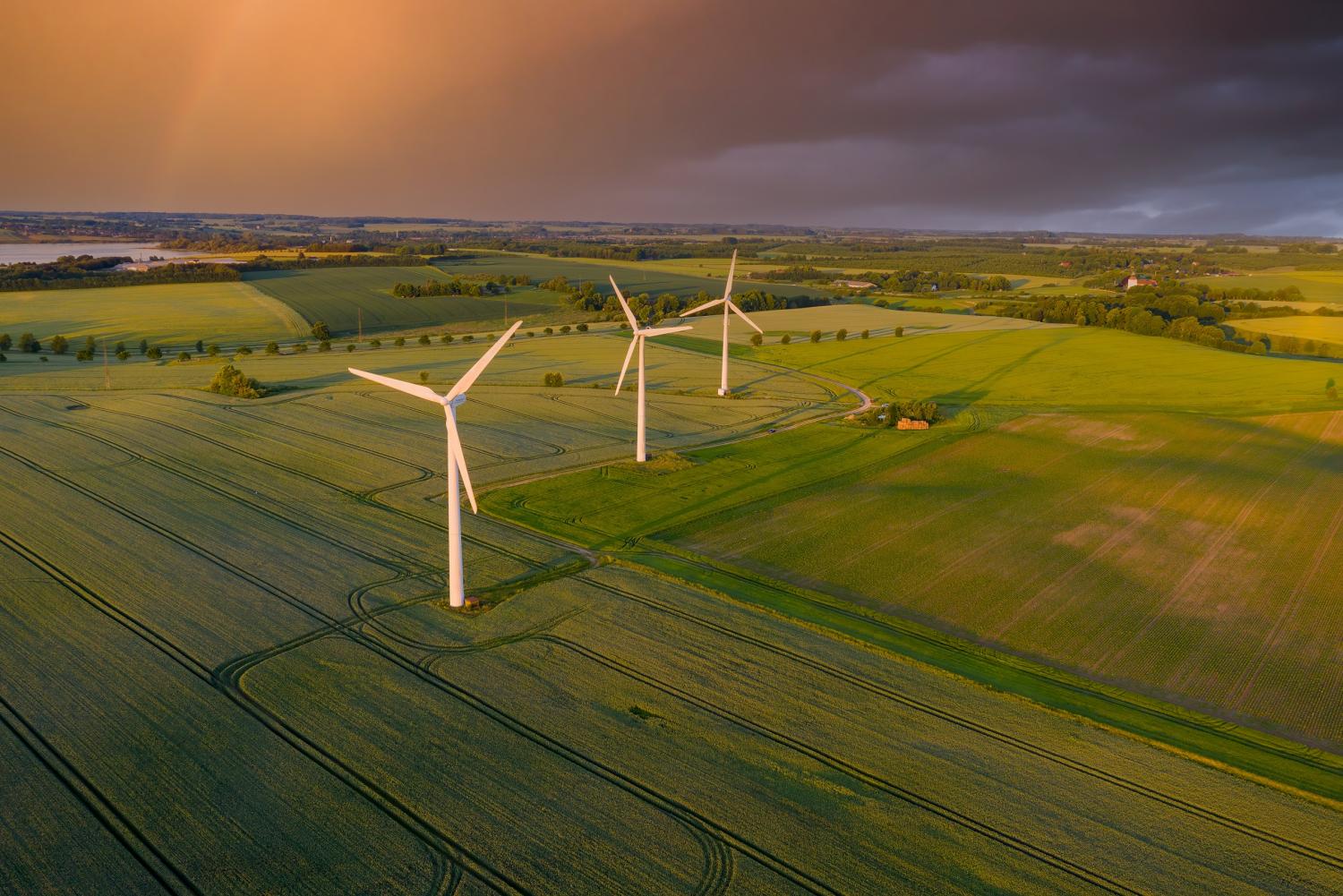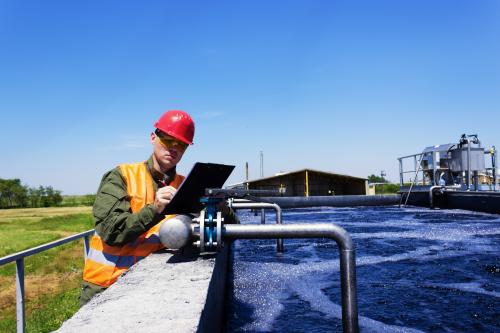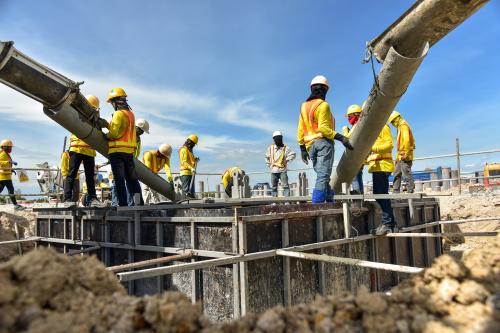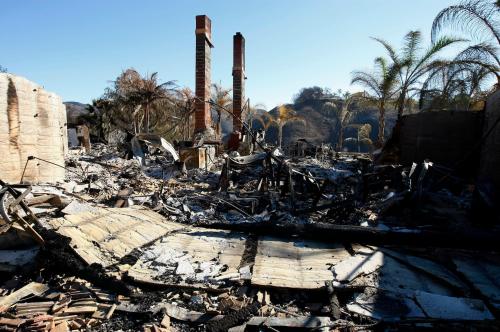Contents
- The need for climate resilient investment across the built environment
- The challenges of scaling climate investment across the built environment
- Principles to scale more climate resilient investment nationally
- Next steps toward a resilient built environment
The impacts of a changing climate are no longer a hypothetical. Each year, extreme events such as hurricanes, droughts, fires, and freezes grow more frequent and more intense—destroying homes, disrupting businesses, and damaging the natural world along the way. Chronic challenges—including gradually rising temperatures, precipitation, and flooding—are adding even more stress. Minimizing and adapting to these impacts must be a priority for every unit of government and every sector of the economy.
Financial markets represent one of the most powerful ways to drive public and private action on climate resilience, as reflected in a May executive order from the Biden administration. The order calls for the Office of Management and Budget, the Department of the Treasury, and other federal agencies to better measure and address financial risks resulting from climate change.
The order’s core intent is for federal agencies and businesses—including financial service firms and insurance companies—to proactively account for and respond to climate risks, including the physical destruction of buildings and the disruption of business operations. Doing so can “promote the flow of capital toward climate-aligned investments and away from high-carbon investments,” as the White House said this April.
This kind of “climate accounting” builds off similar strategies other countries and the business community have developed. And like those peers, the Biden administration is betting that financial principles and more consistent regulations can induce financial markets to reduce climate costs and steer investment toward more resilient outcomes. When combined with other steps outlined in the executive order—including new lending rules for homes and new procurement rules for federal equipment—the ultimate aim and impact could be huge.
While the order is a step in the right direction, it omits several details on the types of financial institutions and flows of capital involved, and overlooks key opportunities to invest in more resilient infrastructure.
The executive order does not address a core set of climate-related failures that expose our built environment—including our transportation, water, and real estate assets—to additional risks and costs. First, communities’ inability to consistently measure or price the negative impacts from a more destructive climate (or the positive impacts from more proactive climate action) is a sizable market failure; the order notes the importance of measurement, but does not specifically link it to our built environment. Second, the lack of mature financial regulations for markets to securitize assets across our built environment is a significant policy failure; the order does not offer guidance on how to consistently identify or invest in specific projects that can boost our climate resilience. Combined, these two failures limit our ability to scale climate investments that can protect and benefit more people and places.
Better financial market design, transparency, and oversight are essential to fixing these failures, reducing costs, and realizing new benefits. We know this approach to using financial market principles can work: the creation of the Securities and Exchange Commission (SEC) during the Great Depression brought greater measurement and investor protection to the exchange of stocks and other securities. The existential threat of climate change should similarly prompt us to explore new ways for financial markets to invest in greater resilience.
This brief explores the climate investment opportunity across our built environment and lays out several market principles that federal leaders should consider when rethinking climate finance. It recommends defining the roles and responsibilities of different actors, from those mobilizing financial capital (investors) to those setting market standards (the SEC and ratings agencies) to infrastructure owners and operators (at a state and local level). We also need to examine what “green standards” already exist to classify certain financial instruments and asset types. Lastly, we need to consider both carrots and sticks to promote investment—ensuring that needed regulations and incentives are in place to guide and catalyze market activity.
The need for climate resilient investment across the built environment
How and where we invest in three specific sectors of our built environment—transportation networks, water facilities, and private real estate assets—has a huge effect on greenhouse gas (GHG) emissions and our overall climate risks. While the U.S. must shift toward cleaner energy sources, federal and local leaders cannot overlook all the unsustainable designs and destructive patterns of growth across our built environment. Our car-centric, sprawling development has gobbled up land, consumed energy, and exposed us to various climate threats. For example, transportation and commercial and residential buildings are responsible for a combined 42% of GHG emissions. This land development model also raises other climate challenges, such as the heat and flood risks created by pavement and other impervious surfaces covering 27% of urban land. Meanwhile, existing roads, pipes, buildings, and other assets can be less environmentally efficient than new construction, more susceptible to climate shocks, and dangerous to individual households and communities.
Three sectors of our built environment face several mounting and interrelated climate investment needs:
- Our transportation infrastructure—including roads and bridges; public transit; bicycle/pedestrian infrastructure; passenger and freight rail; airports; inland waterways; and other related facilities—is not only vulnerable to major storms and other acute climate shocks, but is increasingly in need of repairs and upgrades that reduce pollution, improve access, and enhance more sustainable outcomes. Surface transportation is especially problematic, as the roadway infrastructure to support automobile-oriented development leads to longer travel distances, higher GHG emissions, greater stormwater runoff, and larger maintenance costs.
- Our water infrastructure—including drinking water, wastewater, and stormwater facilities as well as rivers, lakes, and other natural systems—faces a number of scarcity and pollution concerns. Deferred maintenance combined with struggles to plan and pay for needed capital improvements have led to widespread water system failures and inefficiencies. Overwhelmed sewers, leaking pipes, and outdated treatment facilities are resulting in runoff concerns, squandered natural resources, and higher bills.
- Our private real estate assets— for the purposes of this brief, primarily residential and commercial real estate—are fueling higher levels of emissions, runoff, and leaving many people exposed to climate dangers. While industrial buildings and energy generation facilities are leading GHG emitters and tend to attract attention from policymakers and regulators, we cannot overlook the location and design of housing units, commercial buildings, and sprawling land uses that have higher relative pollution impacts. For example, outdated zoning laws and building codes contribute to significant carbon footprints. At the same time, continued construction (and reconstruction) in floodplains and other sensitive areas is straining public budgets and leading to higher costs for many households and businesses. Related runoff concerns on agricultural land also remain a huge challenge for rural communities.
The total value of these assets and scale of the investment needed not only demand more coordinated public and private leadership, but also require fundamentally rethinking climate finance—namely, the market structures and incentives that can boost investment. We can’t solve the climate crisis unless we reconfigure these built environment assets for a resilient future. For instance, according to Bureau of Economic Analysis estimates, these three sectors contain nearly $30.2 trillion in assets, 74% of which is privately owned. Together, the assets across the three sectors account for 58% of all public and private value in physical structures (see Figure 1 note).

The challenges of scaling climate investment across the built environment
Even though climate challenges are mounting across the built environment and the level of needed investment is massive, a lack of coordinated action is perhaps the biggest barrier to drive more resilient infrastructure improvements nationally.
State and local governments are the country’s primary infrastructure owners and operators (alongside other private infrastructure actors, including developers and investor-owned utilities), and they must ultimately prioritize new projects and implement new plans to boost resilience. However, there are thousands of local government and regional entities that own and operate transportation systems and water utilities, each of which may have localized and fragmented climate challenges. Private real estate developers and owners also vary markedly in the types of land, buildings, and other assets they manage in the face of rising floods and other climate pressures.
At the same time, each of these public and private actors may approach their climate needs differently—to say nothing of the varied political views on climate change that can ruffle feathers. Land use regulations and building codes that influence where and what we build are adopted and enforced by state and local governments and may not consistently address climate considerations. The lack of accurate data and methods to quantify benefits and costs around potential infrastructure upgrades—including innovative green designs and technologies—is an additional barrier to investment. Even new financial tools and instruments such as green bonds may not be used consistently across different regions due to the needed programmatic leadership, flexibility, and time to comply with reporting requirements.
The result is a lack of climate resilient investment at scale. Many state and local leaders have limited fiscal capacity to pursue new types of projects, struggle to manage and maintain their existing assets, and must deal with aging, inefficient systems, which leave a legacy of harm for lower-income households and communities of color. On the other hand, many private financial firms may have ample capital to deploy, but lack an investable pipeline of projects and clear market signals on where to invest in infrastructure and real estate. Municipal green bonds, for instance, have jumped from $1.9 billion in 2014 to $9 billion in 2019, but they still only account for a small share of the total volume of all municipal bonds: 2.1% of the $426.4 billion in municipal bond issuances in 2019.

Instead, we too often get one-off projects featuring the same designs, exposing communities to the same vulnerabilities, and drawing from the same types of funding and financing—typically fueled by municipal debt. For example, large, centralized water treatment plants and pipes can quickly channel runoff, but they involve huge construction costs, can be vulnerable to flooding, and do not naturally filter (and protect) our scarce water resources. However, pursuing more flexible, distributed infrastructure upgrades can reduce upfront capital costs, lower climate risks, and enhance economic benefits across whole regions—as Philadelphia has done through its Green City Clean Waters effort and New Orleans through its Gentilly Resilience District, both of which utilize networks of rain gardens and permeable surfaces to absorb stormwater, create jobs, and establish new public green spaces.
Principles to scale more climate resilient investment nationally
The U.S. needs to use the power of financial markets to deliver resilient infrastructure at a national scale. That means establishing a new institutional framework for financial markets that incentivize investment in more resilient infrastructure—or what we called a “resilience marketplace” in a 2019 Brookings report. The federal government should embrace several principles in order to stimulate a robust and effective resilience marketplace.
Such a framework would parallel the creation and implementation of regulations governing the trading of securities, including stocks. During the Great Depression, the 1933 Securities Act and 1934 Securities Exchange Act aimed to ensure investors received more complete, precise information on securities (i.e., disclosures) and established comprehensive guidance on how exchanges of these securities would occur. Rather than only relying on inconsistent, state-specific “blue sky laws,” the federal government created the Securities and Exchange Commission (SEC) to “maintain fair, orderly, and efficient markets” and “facilitate capital formation.” Later reforms further clarified the SEC’s supervisory role, but the underlying market structures and principles remain largely the same—and create precedent for establishing marketplace rules for resilience-focused investment.

Addressing financial market failures is an ideal role for the federal government. Similar to the priorities laid out in the European Union taxonomy on sustainable activities, federal regulators will need to not only better define the types of projects and assets susceptible to climate impacts, but also better define the types of financial instruments and standards to support resilience. Federal leaders should look toward four overarching principles to help financial markets deliver widespread resilient investment:
- Focus on both climate mitigation and adaptation. As the recent executive order on climate-related financial risks describes, addressing climate impacts is not just about predicting and minimizing future emissions; it is about assessing and improving the stability of our current systems amid a more extreme climate. The aim to support a net-zero emissions economy in the coming decades should coincide with ongoing steps to reduce climate risks and minimize costs already hitting households, businesses, and markets. In other words, federal leaders should emphasize investments in both mitigation and adaptation.
- Emphasize built environment investment needs. As laid out in a recent Brookings proposal to create a federal Climate Planning Unit, federal leaders must recognize and reduce the fiscal impacts of climate change by addressing systemic problems across the built environment. Our transportation systems, water facilities, and private real estate assets—including residential and commercial buildings—can all benefit from additional climate monitoring and investment, not just incremental repairs. Across all of these assets, federal leaders need to develop consistent metrics on climate risks (and costs), create financial incentives to encourage climate-conscious investments, and establish a framework to coordinate cross-agency decisionmaking. Federal leaders will also need to identify a clear body, such as the SEC, or set of agencies that will ensure states and localities follow such metrics.
- Target investments around places and people. When focusing on climate needs across our built environment, federal policymakers and private leaders cannot simply identify collections of projects in isolation—for instance, seawalls to reduce flood risks or new housing developments with greener designs. They must gauge needs and potential upgrades based on the uneven climate impacts hitting different communities, including long-standing environmental justice issues facing lower-income households and communities of color. Systemic improvements must involve ongoing community outreach and engagement to prioritize service gaps, affordability concerns, and reliability issues, which can reduce deeply entrenched vulnerabilities. The Biden administration has emphasized the need to steer climate investments toward disadvantaged communities, particularly through a new Justice40 Initiative, which can inform these broader built environment priorities.
- Define and amplify climate-related benefits. Proactively investing in climate mitigation and adaptation across our built environment cannot just be about risk avoidance and cost reduction; we need to identify and measure potential benefits. Having the ability to accurately quantify and price the environmental and economic returns that come with green infrastructure and other improvements makes it possible to evaluate impacts for all types of actors: municipal owners and operators, federal policymakers, private investors, and more. Climate-related benefits could include resource efficiencies, higher property values, and local workforce development opportunities, to name only a few. Since climate costs and benefits are constantly evolving, these measures and prices need to be dynamic and contextualized based on local needs, which will likely require new types of data and pilot efforts. There is also a need for federal regulators to use policy to promote geographic and demographic equity in terms of financial market activity.
Next steps toward a resilient built environment
As federal leaders look to build off the momentum of the recent executive order, they have an opportunity to define new climate-related financial risk strategies, regulations, and structures that can protect and enhance our built environment. Ongoing debates around the American Jobs Plan and other federal infrastructure legislation present an opening to set up financial rules and incentives that can create lasting guidance and change, breaking free from the current cycle of incremental repairs and ad-hoc investment.
What do we need to do to bring this market into practice? As discussed in our previous report, we need to address three areas of distinct need:
- Defining the roles and responsibilities of different actors: from those mobilizing financial capital (investors and lenders) to those setting market standards (the SEC and ratings agencies) to public infrastructure owners and operators (at a state and local level) to private developers and real estate owners.
- Examining what “green standards” already exist to classify certain financial instruments and asset types.
- Considering both carrots and sticks to promote investment and ensure that needed regulations and incentives are in place to guide and grease market activity. Sticks could include new climate disclosure requirements for financial firms, while carrots could include new types of bonds or tax credits aimed at investing in more resilient improvements.
Bridging these gaps in knowledge and practice can create greater certainty for municipalities and private investors as they look to improve our built environment and unleash capital at a scale that can ultimately save the planet. But given the widespread uncertainties and limitations in our current finance system around climate, developing any new strategies and testing any new ideas will take some time.
The current policy window offers an opportunity to focus on the most pressing and easily identifiable climate needs across our built environment, likely starting with the transportation and water challenges facing public infrastructure owners and operators. Doing so can demonstrate measurable progress and build support for larger-scale, longer-term investments over time. This brief offers a starting point to consider these nuanced investment needs, and ongoing research will seek to address other outstanding questions and solutions around future-looking climate investments across our built environment.
The authors thank Tara Pelton and Sophie Abo for excellent research assistance, as well as Jenny Schuetz, Shalini Vajjhala, Carlos Martín, and Sanjay Patnaik for their thoughtful review.
The Brookings Institution is committed to quality, independence, and impact.
We are supported by a diverse array of funders. In line with our values and policies, each Brookings publication represents the sole views of its author(s).









